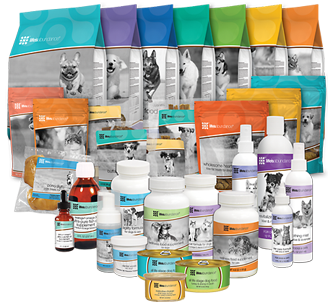How To Give Your Dog Vitamins
 Is your dog getting her vitamins?
Is your dog getting her vitamins?
Even though most dog foods say they’re “complete and balanced,” the nutrition often comes from a bunch of synthetic vitamins and minerals. These aren’t well absorbed by your dog’s body and can even be harmful.
Want to boost your dog’s food? You need to feed extra whole foods.
You may like the idea of giving a vitamin pill every day. It’s quick and easy. But is it best for her?
We get a lot of questions about that from our readers. People ask: “should I give my dog vitamins?” or “what’s the best dog vitamin?”
There are some companies who make natural vitamins from whole foods. So if you want the convenience of a bottled vitamin, buying one of these is a whole lot better than the synthetic kind produced in a laboratory.
But instead of giving your dog something out of a bottle, why not give her some wholesome herbs to provide some extra nutrients along with whatever else you’re feeding?
Giving Your Dog Vitamins: Why Herbs Are Better
In addition to providing vitamins and other nutrients, herbs (whether fresh or dried) offer other benefits to your dog:
- Herbs can contain carbohydrates, fats and proteins along with the vitamins and minerals necessary for good nutrition
- They can boost the immune system
- They can cleanse and alkalize (detoxify) the body
- Whole plants nourish the body on a deep level, reaching the brain, bones, muscles, skin, coat, heart, lungs, liver and kidneys
- Many herbs have medicinal benefits
Which Herbs To Use
Here are a few ideas for nutritional herbs you can add to your dog’s diet. Any of these herbs can be used daily, but you can also rotate them into your dog’s food. Just change what you’re giving daily or even weekly.
Alfalfa
Alfalfa is known as the king of herbs and has been grown for thousands of years.
Alfalfa contains a wealth of vitamins, including vitamins A, C, D, E and K as well as B vitamins. It also contains copper, niacin, calcium, magnesium, iron and potassium and is rich in trace minerals.
Alfalfa is rich in protein (20%), has anti-inflammatory properties. It can help improve arthritis as well as lower cholesterol.
Alfalfa also contains chlorophyll, which has cleansing qualities. The herb is a blood purifier and bitter tonic, and contains the digestive enzyme betaine, which makes it a digestive aid as well.
Caution
When buying alfalfa, choose a certified organic product to avoid buying a genetically modified source.
You can grow it yourself too but it has weed-like tendencies and can spread fast. Use it before it flowers and don’t use the seeds. They contain L-cavanine that can cause blood disorders.
How Much
Add a pinch of dried herb per 10 lbs of bodyweight to your dog’s food per day. If you use store-bought capsules, assume the dose is for a 150 lb human and adjust for your dog’s weight.
Dandelion
You may think of dandelions as an annoying weed, but they’re one of the most nutritious green leafy vegetables you can find.
Dandelion is nature’s richest source of beta-carotene and the third richest source of vitamin A of all foods, after cod-liver oil and beef liver.
Dandelion is rich in vitamins A, C, K, D and the B complex vitamins. It contain potassium, calcium, iron, magnesium, manganese, phosphorus and many other trace minerals. It’s high in fiber and is a good source of protein.
The roots and the leaves both have medicinal properties. The leaves work as a digestive and liver tonic. The root is a cleansing tonic for the liver, gallstones, jaundice and constipation.
Dandelion leaves help flush and tone the kidneys. Dandelion is a powerful diuretic, but it replaces the potassium that’s lost in the process, instead of depleting it as pharmaceutical diuretics do.
You can easily collect dandelions from your lawn and you can use the whole plant – flowers, roots, leaves and stems.
Caution
Make sure your dandelions haven’t been sprayed with herbicides or pesticides.
Since dandelion is a diuretic, make sure your dog has ample opportunity to get outside during the day.
How Much
Chop and dry your dandelions (or buy dried herbs) and sprinkle 1 tsp per 20 pounds of body weight directly onto your dog’s food.
You can also make dandelion tea, using use up to 1 oz dried herb infused in 8 oz water. Give your dog 1/3 cup per 20 pounds of her body weight, up to 3 times a day.
Nettle
Nettle (or stinging nettle) is an especially rich source of vitamin A. It also contains potassium, iron, calcium, and magnesium and supplies phytonutrients such as chlorophyll, sterols, polyphenols, lignans, and gallic acid.
Nettle also acts as a catalyst to help the body absorb many vitamins, minerals and trace minerals as well as several other herbs.
It also has many medicinal qualities, acting as a diuretic and tonic and aiding digestion. It can treat stiff joints and helps purify the blood and cleanse the liver and kidneys.
Nettle can also be used to fight seasonal allergies by treating imbalances of the mucous membranes. You can also apply nettle to stop bleeding in open wounds
You can buy nettle dried or pick it yourself from any source that you’re sure hasn’t been sprayed with pesticides or herbicides.
Caution
Be sure to use gardening gloves to harvest nettle, as “stinging nettle” is well named and will cause an itchy painful rash when it touches bare skin. Cooking removes the stinging quality.
Some pets with plant allergies may be sensitive to nettle.
How Much
Sprinkle dried herb onto food, ½ tsp per day for each lb of food. Or, for finicky dogs, cover fresh young plants with water, cook until tender, then serve with butter and share with your dog!
Burdock Root
Burdock root is a common weed that’s an excellent addition to improve your dog’s overall diet.
Burdock root is high in carbohydrates and inulin. It’s also very high in iron, magnesium, silicon, thiamine, sodium, potassium, phosphorus and chromium.
Burdock is a cleansing herb with a balanced mineral content and acts as a good long term liver tonic, helping to cleanse the blood.
It stimulates digestive juices and bile secretion, which aids digestion and appetite, and absorbs toxins from the bowel.
Burdock is useful in treating skin conditions and can help remove systemic imbalance that may be causing skin issues.
Burdock grows in almost any uncultivated space and it’s also easy to grow yourself. It’s a delicious mild sweet tasting food that you can cook like potatoes or carrots in a stew. Dogs love the taste!
How Much
Stew burdock as described above and add to your dog’s food. Because it’s food, the amount isn’t important, but start out slowly to make sure your dog doesn’t have any digestive issues with a new ingredient.
Alternatively, you can make a tonic using 1 cup of cold water with 2 Tbsp fresh burdock root or 1 to 2 tsp of dried root. Bring to a boil and simmer for 20 minutes. Cool and strain. Refrigerate for up to a week.
Add to food, giving ½ to 1 tsp per 10 lbs of body weight daily.
You can also buy powdered burdock. Assume the package directions are for a 150 lb human and adjust for your dog’s weight.
Kelp
Kelp is a highly nutritious sea plant. It provides over 70 natural vitamins and minerals, including essential trace minerals.
The rich mixture of iodine and other minerals work to keep your dog’s entire glandular system in healthy working order, especially the thyroid, adrenal and pituitary glands.
It contains vitamins A, B1, B2, C, D, E and K, plus amino acids and iron, sodium, phosphorus, calcium, magnesium and potassium.
Kelp can help maintain and cleanse the digestive system and its high iron content fortifies the blood, helping the heart to pump more efficiently. It can help relieve dry, itchy skin and long term kelp supplementation can improve your dog’s skin and coat health.
Kelp nourishes the sensory nerves, brain membranes, spinal cord and brain tissue. It also contains alginic acid, which can help protect the body against the effects of radiation.
Cautions
Because kelp comes from the sea and has the potential for contamination, look a brand that tests for heavy metals and other toxins, especially arsenic.
Don’t give more than the recommended dose because too much iodine can over-stimulate the thyroid and cause other health issues. If your dog’s on thyroid medication, consult your veterinarian before feeding kelp.
How Much
Give your dog ¼ tsp per 10 lbs of body weight daily.
Garlic
Garlic is safe and very beneficial to your dog when fed in moderation. In fact, it’s approved by the Food and Drug Administration (FDA) as a dog food ingredient.
Garlic is high in inulin, amino acids, sulphur, zinc, potassium and phosphorus. It also contains vitamins A, C, and B vitamins, along with calcium, magnesium, manganese, selenium and germanium.
Garlic helps detoxify the body. It supports beneficial bacteria in the digestive tract and eliminates harmful bacteria. It supports the liver and helps your dog eliminate wastes through the entire digestive tract.
It can help prevent blood clots and stimulate the lymph system. Garlic has antibiotic, antifungal and antiparasitic and anti-tumor properties.
Feeding garlic can also help repel fleas and ticks from your dog.
Cautions
Even though garlic is safe for healthy adult dogs, don’t give it to pregnant or nursing females or puppies under six months.
Shiba Inus and Akitas are also said to be sensitive to the hemolytic effects of garlic so don’t feed it to these breeds without checking first with your holistic vet.
Also check with your vet before giving garlic if your dog’s on immune suppressant drugs, heart medications, chemotherapy, blood thinners, insulin, antacids or high blood pressure drugs, as these can interact with garlic.
How Much
Always use fresh, organic, US grown garlic. Peel the cloves then chop it and let it sit 10 to 15 minutes before feeding. This allows allicin, one of the beneficial substances in garlic, to develop. Add to food, giving 1/3 tsp per 10 lbs of your dog’s weight per day.
Giving wholesome herbs to your dog is a wonderful way to get some vitamins and other nutrients into her and deliver some extra health benefits at the same time.


 Life's Abundance Pet Foods
Life's Abundance Pet Foods
Leave a Reply